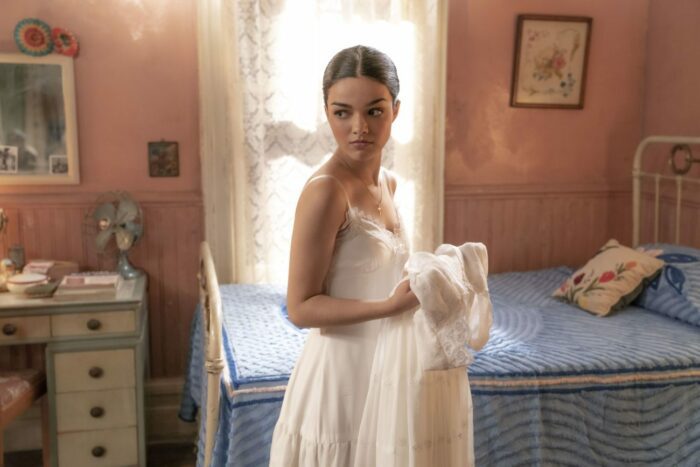There’s a meme-worthy nugget of rhetoric that floats around film-centered social media circles anytime a high-profile remake debuts. The line of questioning asks why studios and filmmakers don’t remake bad movies with room for improvement instead of cherished and iconic classics that don’t need the help. That is precisely the purist’s challenge with Steven Spielberg’s West Side Story arriving 60 years after the film adaptation of the Broadway sensation won ten Oscars including Best Picture.
Many are ready to build those memes right now, and yet it’s like we collectively forgot the clout of the name attached to this new incarnation. It’s Steven f’n Spielberg. If there was ever an apostolic advocate to spectacle and cinema worthy of handling venerated artifacts like West Side Story, he’s near the top of a likely short list. Steven Spielberg would never sully West Side Story. He would swear any oath and seek every consecrated blessing necessary to honor the work of Arthur Larents, Stephen Sondheim, Jerome Robbins, and Leonard Bernstein.
Though the nostalgic director has rightfully earned a carte blanche status from galactic success to make whatever he wants, it feels like Spielberg had not really challenged himself for the better part of the last two decades. Yet, here he is making his first musical with the energy of a man half or even a quarter of his age. Populated with fresh faces, sung with fiery voices, and varnished with spirited hues of toughness and beauty, his resulting West Side Story can win over the purists and cure those remake value worries. We (myself included) can put the memes away for this one.

For those uninformed of the classic story, the upper west side of Manhattan was being glossed up in the 1950s to be a future destination for the well-to-do. The city was intent on razing the old slums and squeezing out the blue and less-than-blue collar immigrant populations within them. Even while the neighborhood was slowly being demolished, a heated ethnic turf war between the newly-arrived Puerto Ricans and the long-standing Caucasian demographics was still being waged in the streets.
The European-rooted “Jets,” organized by the cocky Riff (Mike Faist of TV’s Panic), stand on the nefarious principle that it’s their “instinct to reject and be angry to the unfamiliar.” Ignoring the long arm of the law (represented by the caricatures of Corey Stoll and Brian d’Arcy James), their crosshairs target the Spanish-speaking “Sharks” they despise with bigotry and fail to understand despite their same plebeian plight. The Sharks are led by the up-and-coming boxer Bernardo (David Alvarez of TV’s American Rust).
What they are all mad at is silly, creating the underlying social commentary that was always at the heart of this saga. Nevertheless, both factions lust for the opportunities to show their rivals up. Both battlefronts are populated with packs of blindly loyal brotherhoods ready at the drop of a piano chord or snapped finger to gnash teeth, zing threats, put up their dukes, or join in song-laced choreography.

Intentionally taking a page from Shakespeare, the new development with the power to either heal this urban divide or explode it wider is a case of forbidden love. Tony (Baby Driver’s Ansel Elgort), a reformed Jet, is trying to walk the straight and narrow after a year in prison by working for and living with a benevolent local shop owner named Valentina (a revised character updated for original West Side Story Oscar winner Rita Moreno). He falls head over heels for Bernardo’s attractive younger sister Maria (newcomer Rachel Zegler), who teams with her brother’s vivacious main squeeze Anita (Schmigadoon!’s Ariana DeBose) as a third-shift department store cleaning lady. Maria swoons too and, soon enough, their tryst behaviors and nighttime ballads of thinking for themselves become exposed, leading to a downfall of misinformation and non-acceptance.
Reteaming with Pulitzer Prize-winning playwright Tony Kushner for the third time following Munich and Lincoln, Spielberg sought to adapt the original 1957 play directed and choreographed by Jerome Robbins more than the 1961 Robert Wise-stewarded film. No matter the chosen emphasis, we’re in remake territory, where the tolerance for diehards and casual fans alike shifts between what was retained and what was updated. From a narrative structure standpoint, the eager and curious nitpickers can read up on the specific differences if necessary. As a movie musical, the elements of look and sound matter the most for the dichotomy happening with those comparative measurements between old and new.
This is where the masterful craftsmanship of Steven Spielberg and his fellow Academy Award-winning veteran collaborators shines like no other. The visual texture of this film is enormous and beyond the window dressing level of a Disney “reimagining” by comparison. Redressed Manhattan, Harlem, Brooklyn, and New Jersey locations seamlessly blend with staggeringly detailed interior sets conceived by The Grand Budapest Hotel’s Adam Stockhausen. Every puddle, pile, clothesline, and fictitious brick looks like it’s been there for decades. Likewise, the vivid costume designs of Hamilton Tony Award winner Paul Tazewell pop off the gyrating dancers and their sweaty lapels.
Each physical element is captured gloriously by cinematographer Janusz Kaminski. The double Oscar winner steeps this musical in a moody mix of shadow and light that accentuates the contentious and tragic scope of this story. His lens flares count as amplified modern sharpness even when they are a little much in concentration and frequency. Still, even as a senior in his discipline, Kaminski is achieving daring crane movements and blocking kinetic and sizable performance numbers better than many of his contemporaries could ever muster.
It should also come as no surprise that a Steven Spielberg film sounds immaculate. Composer David Newman and conductor Gustavo Dudamel rearranged and rechanneled Leonard Bernstein’s magnificent original score to voluminous success. Trading science fiction scale for a concrete jungle, Gary Rydstom, the 7-time Oscar winner and best in the business at sound mixing, designing, and editing, combines the soundscape of the physical settings with the musical’s symphony-fueled waterfall of noise. Finger snaps and floor-scraping shoes lance clearly through songs and dances when they need to in full Dolby Atmos.
If there is a stratum art or craft cannot touch or manipulate in a movie musical, it’s the emotional impact. As pretty or as tuned as something is constructed, sweep is never automatic. That’s on the songs and the performers. Tony-winning choreographer Justin Peck (Carousel) put everyone in perfect positions to show their character-defining passion alongside their energetic talent for Stephen Sondheim’s beloved and intact songs.

The aforementioned fresh faces are what make this West Side Story a tremendous win, especially among the women. The debuting (and future Snow White) Rachel Zegler and Ariana DeBose are revelatory finds and can knock the socks off of any man, woman, or child watching them on-screen. Their belted solo numbers, along with a special and tender singing moment for Rita Moreno, rattle souls. Coupling very good vocal work of their own with electric physical performances as combative figures, the dueling standouts of Mike Faist and David Alvarez assert themselves powerfully as well.
If there is a weak link where sweep and magnetism are deficient, it’s unfortunately coming from the biggest name and main lead on the roster. Ansel Elgort expresses a beautifully pronounced vibrato to suit the musical requirements and, as seen in Baby Driver, the dexterity to have pep in his step. Even so, his screen presence noticeably does not fuse into West Side Story, beset with some of the same drab acting mannerisms that doomed The Goldfinch for him. This may sound oddly condemnatory, but Elgort looks too old and too tall next to his West Side Story ensemble mates, especially Zegler. Spielberg uses steps, props, ledges, and awkward contortions to try and hide or trim his 6’ 3” frame, but he lives up to the “stick out like a sore thumb” expression alongside to the natural aura of everyone else.
Put it all together and Ansel’s Tony does not sell us on the knee-buckling intensity necessary to woo game-changing love or thwart community strife. That’s the top glaring weakness in an otherwise triumphant achievement from one of cinema’s true greats flexing his powerful intent to honor something he adored as an aspiring filmmaker. Never doubt Steven Spielberg.




I think you’re being a little unfair to Elgort and maybe falling for a theater stereotype where women are petite and men are dapper. Elgort’s big galoot of a Tony is a nice break from that, particularly when he clamors up the fire escape fencing in tennis shoes: so funny (like Romeo and Juliet, WSS is still a comedy at this point, no one dead yet).
In the earlier scene with Tony and Maria under the bleachers, the filmmakers even got in a little joke about their big difference in height, perhaps a sly reference to the big difference in background that will try to keep the couple apart. This scene is analogous to the scene in R&J where R&J speak the sonnet to each other (with all its references to hands and palms and lips) and then kiss.
In R&J, Romeo’s lines suggest that he’s the one who initiates the kiss, but here Maria is the one who does, practically leaping up to his face and catching him by surprise. Thus the swapping of Juliet’s line (“You kiss by the book”) to Tony (“I’m a by-the-book type”) makes sense and is another nice little joke (actually two jokes, as Maria doesn’t understand this idiomatic expression). If Elgort were shorter, these jokes would probably be lost.